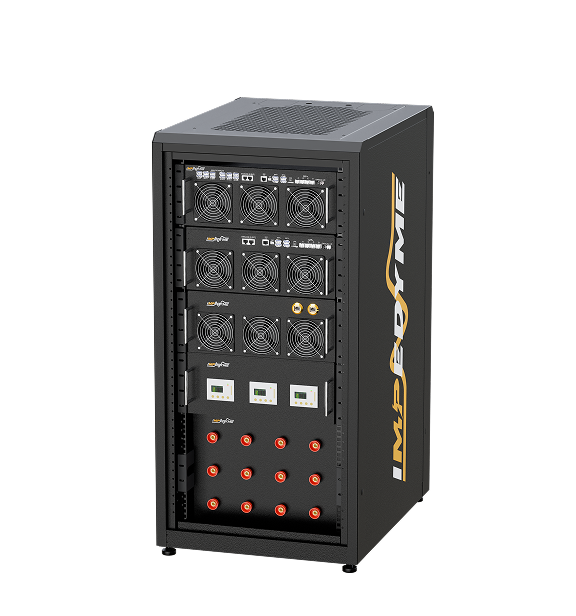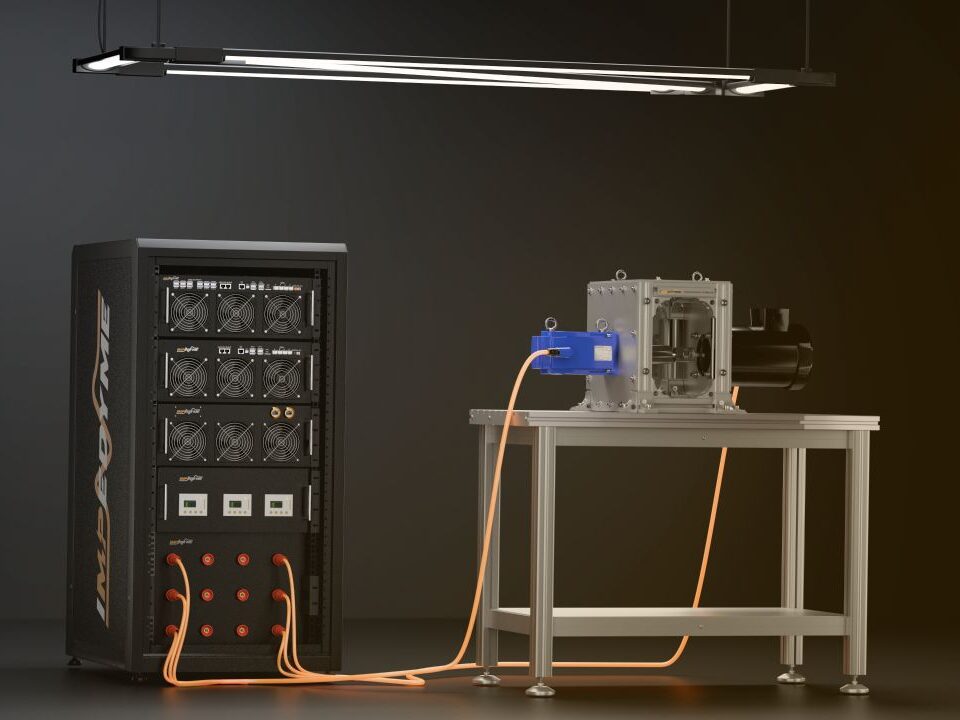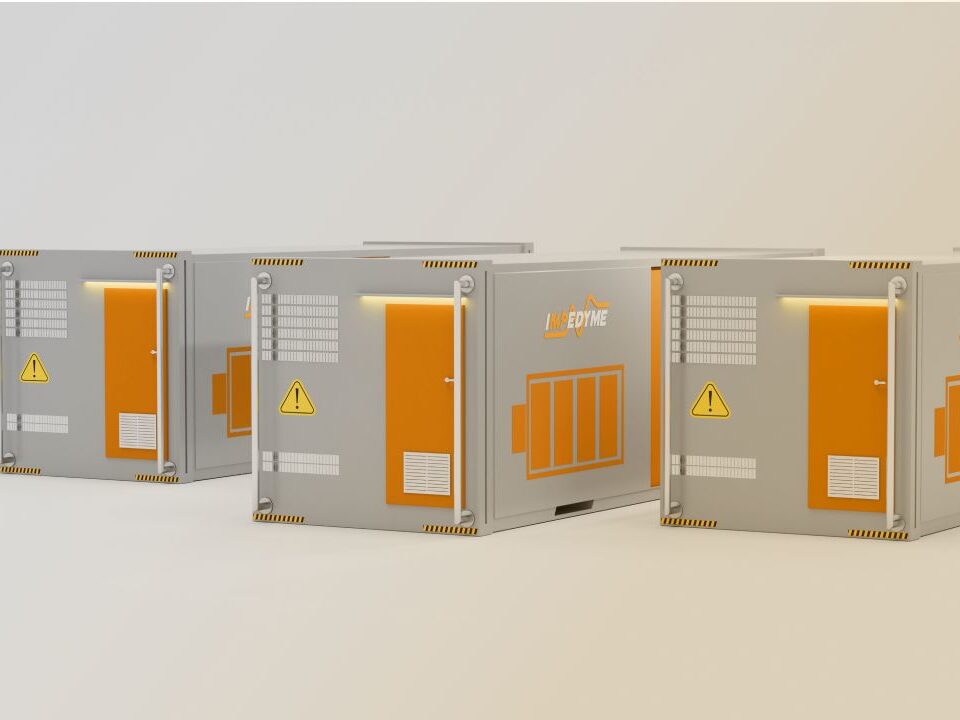
-
 Induction Motor
Induction Motor
-
 Automotive Electrical System Simulation
Automotive Electrical System Simulation
-
 DC/DC Bidirectional Converter
DC/DC Bidirectional Converter
-
 PWM Control for Brushless DC
PWM Control for Brushless DC
-
 BLDC Motor Control and Drive Simulation
BLDC Motor Control and Drive Simulation
-
 Electric Vehicle Fast Charger Simulation
Electric Vehicle Fast Charger Simulation
-
 DFIG Wind Turbine Simulation
DFIG Wind Turbine Simulation
-
 Dual Active Bridge
Dual Active Bridge
-
 EV Dynamometer Test Environment Simulation
EV Dynamometer Test Environment Simulation
-
 Electric Vehicle Simulation
Electric Vehicle Simulation
-
 Three-Phase Grid-Connected Inverter Using Direct-Q…
Three-Phase Grid-Connected Inverter Using Direct-Q…
-
 Three-Phase Grid-Connected Solar Photovoltaic
Three-Phase Grid-Connected Solar Photovoltaic
-
 Grid-Connected Rectifier
Grid-Connected Rectifier
-
 Grid-Tied Inverter System
Grid-Tied Inverter System
-
 Torque Control in a Hybrid Excitation Synchronous …
Torque Control in a Hybrid Excitation Synchronous …
-
 Wye-Delta Starting Circuit
Wye-Delta Starting Circuit
-
 IPMSM-Based Axle-Drive
IPMSM-Based Axle-Drive
-
 Simplified Parallel Hybrid Electric Vehicle
Simplified Parallel Hybrid Electric Vehicle
-
 Simplified Series Hybrid Electric Vehicle
Simplified Series Hybrid Electric Vehicle
-
 Series-Parallel Hybrid Electric Vehicle
Series-Parallel Hybrid Electric Vehicle
-
 Three-Phase Matrix Converter Simulation
Three-Phase Matrix Converter Simulation
-
 Venturini Modulation for Three-Phase Matrix Conver…
Venturini Modulation for Three-Phase Matrix Conver…
-
 Microgrid Frequency Regulation Using Vehicle-to-Gr…
Microgrid Frequency Regulation Using Vehicle-to-Gr…
-
 Three-Phase Modular Multilevel Converter
Three-Phase Modular Multilevel Converter
-
 Field-Oriented Control
Field-Oriented Control
-
 Interior Permanent Magnet Synchronous Generator
Interior Permanent Magnet Synchronous Generator
-
 Permanent Magnet Synchronous Machine
Permanent Magnet Synchronous Machine
-
 PMSM Rotor Angular Velocity
PMSM Rotor Angular Velocity
-
 PMSM-Based Electrical Traction Drive
PMSM-Based Electrical Traction Drive
-
 Maximum Power Point Tracking
Maximum Power Point Tracking
-
 Six-Phase Permanent Magnet Synchronous Machine
Six-Phase Permanent Magnet Synchronous Machine
-
 Synchronous Machine-Based Electrical Drive Simulat…
Synchronous Machine-Based Electrical Drive Simulat…
-
 Single-Stage Solar Inverter
Single-Stage Solar Inverter
-
 Three-Phase Cycloconverter Simulation
Three-Phase Cycloconverter Simulation
-
 Totem-Pole PFC Simulation
Totem-Pole PFC Simulation
-
 Twelve-Pulse Thyristor Rectifier
Twelve-Pulse Thyristor Rectifier
-
 Two-Wheeler On-Board Charger
Two-Wheeler On-Board Charger
-
 Vienna Rectifier Simulation
Vienna Rectifier Simulation
-
 High-Voltage Direct Current
High-Voltage Direct Current
-
 Wireless Power Transfer
Wireless Power Transfer
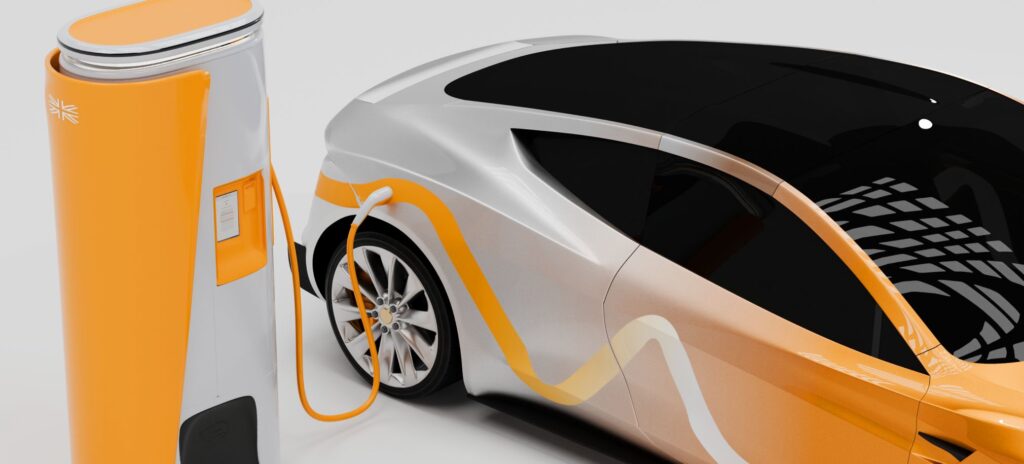
Comprehensive Documentation for Electric Vehicle Fast Charger Simulation
Table of Contents
- 1 Comprehensive Documentation for Electric Vehicle Fast Charger Simulation
- 1.1 Introduction
- 1.2 System Overview
- 1.2.1 What is an Electric Vehicle Fast Charger?
- 1.3 Key Features
- 1.3.1 Grid Integration and Power Quality
- 1.3.2 Multi-Stage Power Conversion
- 1.3.3 Intelligent Charging Control
- 1.4 Control System and Strategy
- 1.4.1 Rectifier Controller
- 1.4.2 Converter Controller
- 1.5 Simulation Objectives
- 1.6 Advantages of EV Fast Chargers
- 1.7 Applications
- 1.7.1 Public Charging Networks
- 1.7.2 Commercial Fleets
- 1.7.3 Public Transportation
- 1.7.4 Automotive Industry
- 1.7.5 Home and Commercial Charging
- 1.8 Simulation Benefits
- 1.9 Summary
- 1.10 Future Enhancements
- 1.11
- 1.11.1 Induction Motor
- 1.11.2 Automotive Electrical System Simulation
- 1.11.3 DC/DC Bidirectional Converter
- 1.11.4 PWM Control for Brushless DC
Introduction
The Electric Vehicle (EV) Fast Charger Simulation is a comprehensive model designed to demonstrate the power conversion and control processes involved in high-power EV charging. This system efficiently converts AC grid power to regulated DC power for battery charging, ensuring optimal performance, power quality, and system reliability. The simulation falls under the domain of Electric Vehicle Charging Infrastructure, supporting advancements in sustainable transportation.
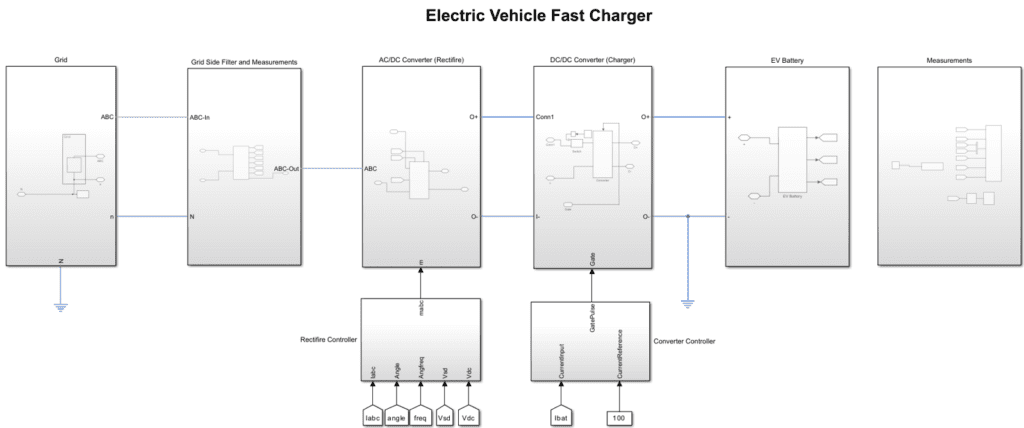
System Overview
What is an Electric Vehicle Fast Charger?
An EV fast charger is a power electronics system that facilitates rapid energy transfer from the electrical grid to the EV battery. It consists of multiple conversion stages to ensure efficient power delivery while maintaining grid stability and power quality.
Purpose of the Simulation The simulation aims to:
- Demonstrate the AC-DC and DC-DC power conversion processes.
- Validate power factor correction and voltage regulation techniques.
- Analyze system efficiency, power quality, and control strategies.
Key Features
Grid Integration and Power Quality
The simulation ensures seamless grid integration by managing power factor and minimizing harmonics.
➡️ HIL/PHIL Benefit: Real-time validation of grid compliance and power quality improvements.
Multi-Stage Power Conversion
The system includes:
- AC/DC rectifier: Converts AC grid voltage to a regulated DC voltage.
- DC/DC converter: Adjusts the output voltage to match battery charging requirements.
➡️ HIL/PHIL Benefit: Allows real-world testing of conversion efficiency and loss reduction.
Intelligent Charging Control
Incorporates adaptive control algorithms for optimal charging speed and battery longevity.
➡️ HIL/PHIL Benefit: Enables real-time evaluation of charging profiles before deployment.
Control System and Strategy
Rectifier Controller
- Measures phase currents, voltage angle, and frequency.
- Implements power factor correction strategies.
- Ensures stable DC-link voltage for downstream conversion.
Converter Controller
- Regulates DC output to match battery charging requirements.
- Implements current and voltage control loops.
- Ensures safe operation under varying grid and battery conditions.
Simulation Objectives
This simulation evaluates:
- AC-DC and DC-DC conversion efficiency.
- Power factor correction effectiveness.
- Battery charging profiles and control.
Advantages of EV Fast Chargers
- Rapid Charging: Reduces EV charging time significantly.
- Power Factor Control: Maintains near-unity power factor, ensuring grid compatibility.
- High Efficiency: Optimized power conversion reduces energy losses.
- Scalability: Can be adapted for different power levels and vehicle types.
Applications
Public Charging Networks
Highway Charging Stations: Fast chargers are deployed along highways and major roads to enable long-distance travel for EVs, reducing range anxiety.
Urban Charging Hubs: Fast chargers are installed in urban areas, such as parking lots, shopping malls, and public garages, to provide convenient charging options for EV owners.
Commercial Fleets
Logistics and Delivery: Fast chargers are used by logistics companies to charge electric delivery vans and trucks, ensuring minimal downtime and efficient operations.
Ride-Sharing and Taxis: Fast chargers support electric ride-sharing and taxi services by enabling quick turnaround times for vehicles.
Public Transportation
Electric buses and shuttles use fast chargers at depots and terminals to maintain operational schedules.
Automotive Industry
Dealerships and Service Centers: Fast chargers are installed at car dealerships and service centers to charge EVs for test drives, sales, and maintenance.
Manufacturing Facilities: EV manufacturers use fast chargers to charge vehicles during production and quality testing.
Home and Commercial Charging
Integrated solutions for personal and business use.
➡️ HIL/PHIL Benefit: Enables real-time simulation of these applications to ensure robust performance.
Simulation Benefits
With this simulation, users can:
- Analyze charger efficiency and power quality.
- Optimize charging strategies for extended battery life.
- Evaluate the impact of different grid conditions on charging performance.
➡️ HIL/PHIL Benefit: Ensures smooth transition from simulation to real-world deployment.
Summary
The EV Fast Charger Simulation provides a detailed framework for studying power conversion, grid integration, and battery charging strategies. Impedyme’s HIL and PHIL solutions enhance the development process:
| Development Stage | Impedyme’s Contribution |
|---|---|
| Control Design | RCP using HIL for rapid algorithm validation |
| Control Hardware Testing | CIL with real-time power converter models |
| Power Stage Verification | PHIL with real voltage and power interaction |
| Final Validation | Full-system PHIL under realistic load conditions |
Future Enhancements
- Integration of AI-based adaptive charging algorithms.
- Advanced grid-to-vehicle (G2V) and vehicle-to-grid (V2G) interaction.
- Implementation of wireless charging for improved user convenience.
The EV Fast Charger Simulation serves as a vital tool for developing next-generation charging infrastructure. With Impedyme’s HIL/PHIL solutions, engineers can optimize charging efficiency, improve grid interaction, and validate advanced control strategies before real-world deployment.
